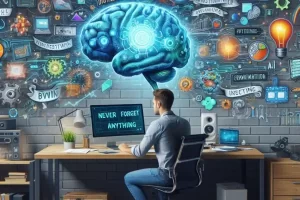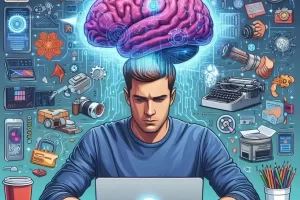Creating a second brain is not just about collecting notes and tasks — it’s about building a system of thinking. When enhanced by artificial intelligence, your second brain becomes more than a place to store information — it becomes a digital partner that helps you think better, remember more, and create with clarity.
In this article, we’ll break down the core principles you should follow when building a second brain with AI. These foundations will help you avoid common mistakes, make the most of your tools, and create a system that truly supports your goals and lifestyle.
Principle 1: Capture Everything That Has Value
Your second brain begins with capturing ideas, thoughts, references, and insights. AI tools can help automate and speed up this process, but the principle remains: if it might be useful later, capture it now.
Examples of what to capture:
- Interesting quotes from books or podcasts
- Ideas you have during the day
- Meeting notes or conversations
- Tasks, goals, or reflections
Use tools like:
- Readwise for automatic highlight capture
- Notion or Obsidian for typed notes
- Otter.ai for voice-to-text transcription
- ChatGPT for converting scattered thoughts into structured notes
The key is not to judge the value of an idea in the moment — just capture.
Principle 2: Organize for Retrieval, Not Perfection
A major mistake when building a second brain is trying to organize everything perfectly. AI helps simplify this by tagging, linking, and grouping for you, but your mindset should be focused on making information easy to find later, not creating a flawless structure.
Instead of endless folders, think in terms of:
- Projects: Things you’re actively working on
- Areas: Ongoing responsibilities (Health, Work, Finances)
- Resources: Knowledge and references
- Archives: Old content you don’t need often
Let AI help with:
- Auto-tagging notes by topic or category
- Suggesting related ideas or tasks
- Clustering similar content over time
Ask ChatGPT:
“What are the main themes in these last 10 notes?”
“Group these entries by subject.”
Let your second brain evolve, not stay static.
Principle 3: Make Ideas Actionable
Ideas are only useful when they lead to action. A second brain should help you turn insight into output. AI can assist in making this easier.
Examples:
- After journaling, ask ChatGPT: “What tasks or habits should I start based on this reflection?”
- After reading a blog post, ask: “Create a checklist of actions based on this article.”
Notion AI and Obsidian plugins can help convert notes into tasks automatically, and tools like Tana or Mem.ai suggest follow-up actions based on your activity.
Don’t let your second brain become a dead archive. It should generate movement.
Principle 4: Connect Everything You Know
Human thinking is associative — we think in connections. Your second brain should mirror that, and AI is excellent at recognizing links between ideas, even when they’re not obvious to you.
Use your AI to:
- Link related notes
- Suggest follow-ups
- Map out recurring themes
- Build a knowledge graph
In Obsidian, bi-directional linking lets you connect one note to many others. With AI plugins, those links can be suggested for you.
Ask:
“What past ideas relate to this new note?”
“Are there patterns across my last 5 entries?”
Connections make your knowledge more powerful.
Principle 5: Review Regularly to Strengthen Memory
A second brain is not just a database — it’s a memory enhancer. The more you revisit, reflect, and reprocess, the more you remember and apply.
Make review a weekly habit:
- Summarize what you learned
- Revisit highlights and notes
- Plan your week based on recent inputs
AI can help:
- Readwise resurfaces old notes using spaced repetition
- ChatGPT can create a weekly summary of your activity
- Notion AI can help you reflect on journal entries
Prompt:
“Summarize what I learned this week and what I should focus on next.”
The more you review, the more your second brain becomes a thinking loop — not just a filing cabinet.
Principle 6: Let AI Do the Heavy Lifting
One of the greatest advantages of building your second brain in 2025 is that you’re not alone. AI can:
- Transcribe
- Summarize
- Sort
- Search
- Suggest
- Plan
You don’t need to manually sort every note or plan every task. Let ChatGPT, Notion AI, Mem, and others handle structure and logic, while you focus on creativity and decision-making.
Think of your AI as:
- An intelligent assistant
- A research partner
- A memory guide
- A productivity strategist
Ask it questions like:
“What is the most important task I haven’t done yet?”
“Based on my goals, what should I review this month?”
“Suggest new habits based on my last journal entry.”
The AI doesn’t replace you — it augments your thinking.
Principle 7: Keep It Simple, Use It Daily
The best second brain is not the most complex. It’s the one you use every day. Avoid over-engineering the system. Let AI reduce friction and keep your workflow light.
A daily flow might include:
- Capturing 2–3 ideas or notes
- Asking AI to summarize your plan for the day
- Reviewing a note or quote
- Organizing one thing using tags or links
- Journaling briefly and asking AI for a reflection summary
Small, consistent steps make your second brain stronger every day.
Final Thoughts: Build a Thinking System, Not Just a Note Archive
A second brain is more than a place to save things. It’s a place to grow, revisit, and refine your thinking — and with AI, this becomes easier and more powerful than ever before.
Follow these principles to create a second brain that adapts to you, works with you, and helps you get better over time. AI can remember, organize, and connect — but your role is to think, reflect, and act.
That’s the real partnership: Your mind + AI = Unlimited clarity.




